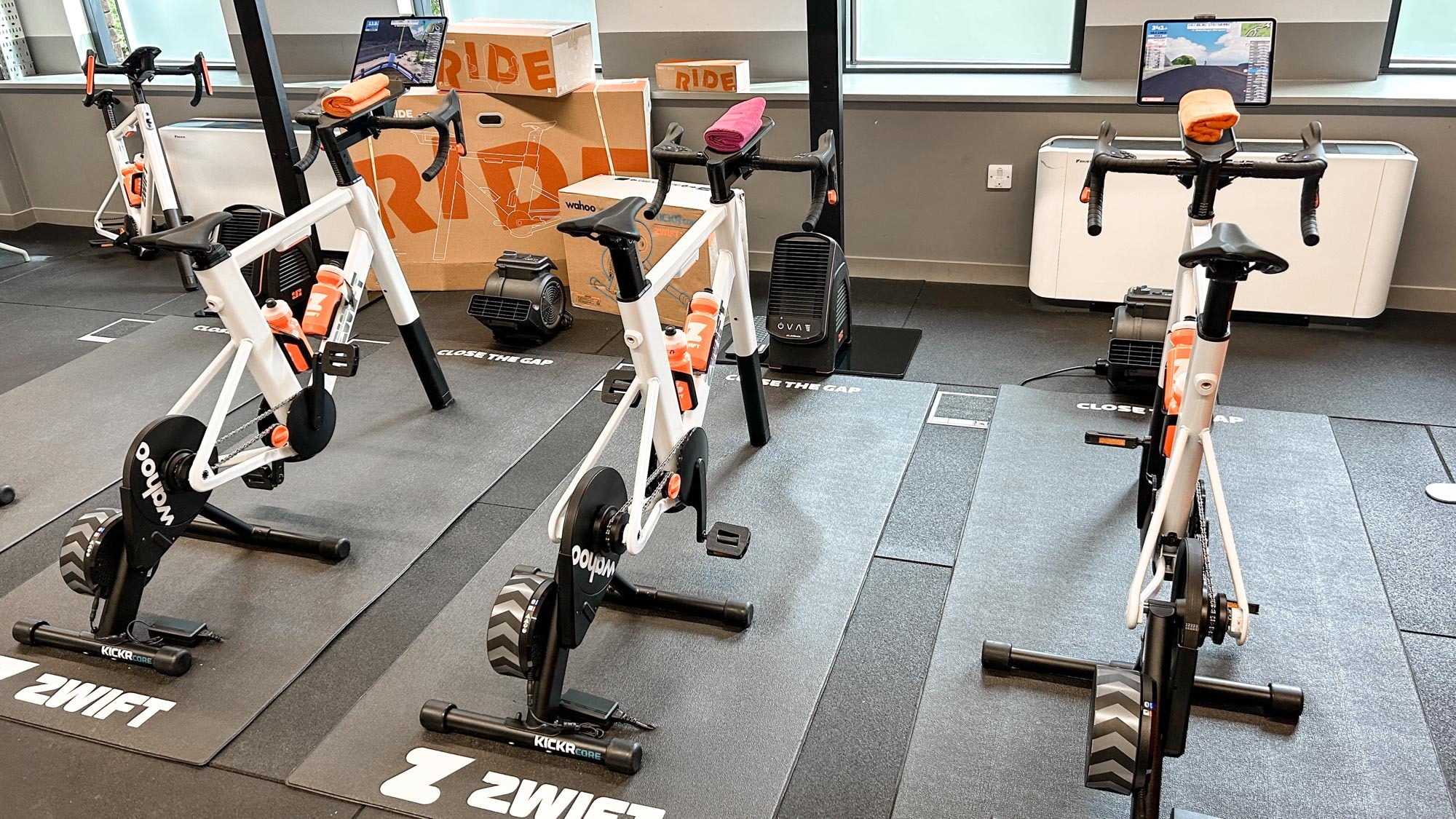I tried Zwift Ride — is this the best way to cycle indoors?
Zwift Ride is the best value smart bike for indoor rides

If you've ever cycled indoors, you don't need me to tell you it can be a little boring without external motivation like a spinning class or a TV show to watch. Since its launch in 2015, Zwift has revolutionized indoor cycling by gamifying the experience so you control an avatar cycling through beautiful virtual worlds.
The Zwift Ride smart bike aims to make the Zwift app more accessible than ever, with an easy setup process that will get you riding with minimal fuss. It’s also more affordable than most smart exercise bikes, and the quiet, aesthetically-pleasing design means it can be used inside, not just the garage.
I gave the Zwift Ride a try ahead of its full launch; here’s what you need to know.
Zwift Ride: price and availability
The Zwift Ride will be available from June 26th and costs $1,299.99 / £1,199.99 plus $75 / £65 shipping. This is for a package that contains the Zwift bike frame with a Wahoo KICKR CORE turbo trainer, which is the only way to buy the Zwift Ride at the moment.
Later this autumn you will be able to just buy the Zwift Frame itself, which you can then connect to other indoor cycling trainers including the Zwift Hub and Wahoo KICKR. To be compatible with the Zwift Frame a turbo will need to work with the Zwift Cog attachment, which joins the frame to the trainer, and Zwift are working with other turbo trainer companies to make compatible products.
To use Zwift Ride with Zwift you need a subscription for the app, which is $19.99 / £17.99 a month or $199.99 / £179.99 a year. You can use the bike without connecting it to any app, and the Wahoo KICKR CORE will connect to other virtual training apps too, though at this point you can’t shift gears in other apps using the Zwift Frame controls.
What is Zwift Ride?

Zwift Ride is a package containing the Zwift Frame and the Wahoo KICKR CORE turbo trainer. It comes in three boxes to make it cheaper to ship than one large box (and easier to carry up stairs when it arrives), and the setup process is designed to be as simple as possible even if you’re not someone who does a lot of bike riding and maintenance.
Accessibility is at the core of everything with the Zwift Ride. It’s cheaper than other smart bikes — you’ll pay $2,500-$5,000 for the top smart bikes from Wattbike or Wahoo — and because of the Zwift Cog you don’t even need to know what a ‘cassette’ is to connect the frame to the KICKR CORE turbo.
This speaks to me as a keen indoor cyclist who doesn’t ride much outdoors, who needed to enlist a bike-mad friend to connect my road bike to a turbo trainer when I got the latter years ago, because working out how to connect the specific gears of my bike to the turbo was beyond me.

The Zwift Ride setup is cleaner and more elegant than rigging your outdoor bike up to a turbo, so it’s better to use indoors, and it requires minimal maintenance beyond dusting it like any other bit of furniture. In short, it’s built to be the easiest way to ride indoors and link up with Zwift, making the app more accessible to people who aren’t already keen cyclists.
It’s also easy to adjust the Zwift Frame to fit different people, so everyone in the household can jump on quickly. One tool is all you need to adjust the saddle height and handlebars, and this tool is conveniently located on the underside of the top bar of the frame. Zwift also includes a sizing guide card which gives you the letter to adjust each part of the bike to in line with your height, to create a more comfortable riding position.
On the handlebars of the Zwift bike are controls you can use to navigate the Zwift app mid-ride, as well as virtual gear shifters. Once you’re linked to Zwift the app will control the Wahoo KICKR CORE turbo trainer to simulate the inclines on the virtual route you’re riding, with the app containing 10 worlds to explore including the stunning fictional island of Watopia as well as real places, with routes through France and Scotland, for example.
There is a tray on the handlebars that you can put your phone and a towel on, along with any nutrition you need for your ride like gels or bars, and there are two bottle holders on the frame itself. Zwift also sells a tablet holder attachment ($49.99 / £39.99) which will be invaluable if you use the Zwift app on a tablet rather than a TV.
What’s it like to cycle on the Zwift Ride?

I have used Zwift regularly for many years and probably prefer it to outdoor cycling at this point. I ride indoors as a way of cross-training and supporting my running, which is my main sport, rather than for any particular love of cycling, and using a turbo trainer for an indoor ride to do this is safer and easier for me.
Compared to my setup of an old, dirty road bike on a turbo trainer in the garage, the pristine white Zwift Ride feels very glamorous, though it might still be a stretch to convince the family to let me bring it inside the house.
Adjusting the seat and handlebars to suit my height took seconds, and the bike runs very quietly and changes gear smoothly and almost silently using the virtual shifters. The bike is less noisy than a fan — and I do certainly recommend having a fan blasting you whenever you cycle indoors; it’s a sweaty endeavor.
Cycling through the virtual worlds in Zwift is always an enjoyable experience and the KICKR CORE adjusts the resistance rapidly to recreate the climbs and descents you ride in the app. Using the controls on the Zwift Frame, I was able to try steering in Zwift for the first time, tackling a short game-like ride where you veer from side to side to collect power ups while cycling.
It’s certainly a more enjoyable and quieter experience to use the Zwift Ride than my bike connected to a turbo, and if I was starting afresh with indoor cycling it would be a more appealing option than buying a standalone turbo trainer, even assuming you do have a bike you can attach to it. The spotless Zwift Ride also looks better in an apartment or house than a bike you also use outdoors on a turbo, if you don’t do your indoor training in a garage.
I’ll do a lot more testing of the bike for a full review in time, but for now it seems like the Zwift Ride will hold more appeal to relative newcomers to indoor cycling, and casual cyclists in general, as opposed to committed outdoor riders who will probably get better value in buying and using a turbo. If you’re in the market specifically for a smart bike, however, the Zwift Ride certainly represents the best value I’ve come across.
More from Tom's Guide
Sign up to get the BEST of Tom's Guide direct to your inbox.
Get instant access to breaking news, the hottest reviews, great deals and helpful tips.

Nick Harris-Fry is an experienced health and fitness journalist, writing professionally since 2012. He spent nine years working on the Coach magazine and website before moving to the fitness team at Tom’s Guide in 2024. Nick is a keen runner and also the founder of YouTube channel The Run Testers, which specialises in reviewing running shoes, watches, headphones and other gear.
Nick ran his first marathon in 2016 after six weeks of training for a magazine feature and subsequently became obsessed with the sport. He now has PBs of 2hr 27min for the marathon and 15min 30sec for 5K, and has run 13 marathons in total, as well as a 50-mile ultramarathon. Nick is also a qualified Run Leader in the UK.
Nick is an established expert in the health and fitness area and along with writing for many publications, including Live Science, Expert Reviews, Wareable, Coach and Get Sweat Go, he has been quoted on The Guardian and The Independent.
